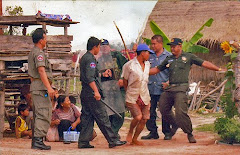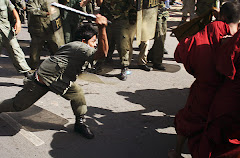By: SOURN SEREY RATHA
The mixed National-International Extraordinary Chambers in the Courts of Cambodia (ECCC) issued a statement on August 8, 2008 that its investigating judges issued an indictment upon ending their investigation of Kaing Guek Eav — also known as Duch — who was the overseer of the Phnom Penh prison used as a torture center. Khmer rouge victims welcomes the indictment of Kaing Guek Eav.
However, the ECCC have to broaden and deepen its investigations and prosecutions to include those high ranking officials who commanded the Santibal (Security forces) during the Khmer Rouge regime and ordered and executed those orders that resulted in the mass slaughter of tens of thousands of Cambodians.
Without doubt, the ECCC investigations and verdicts must be based on evidence that is beyond reasonable doubt.
What evidence can the ECCC use on to make its decision about its investigations and verdicts?
According to HUN SEN government, it could be in the form of: Quote
· Documents;
· Physical evidence, such as mass graves and former prisons;
· Statements and testimony by victims, witnesses and defendants.
Thousands of documents have been collected and hundreds of mass graves, prisons and memorials have been mapped by the Research Committee of the Salvation Front (Renakse), the Documentation Center of Cambodia (DC-Cam) and the Cambodian Genocide Program. These will be made available to the court. Unquote
At the Nuremberg Court that was created immediately after the victory of the Allied Forces, the evidence could be reasonably established because the majority was recent, less than four years old, and memories were still fresh; however, the evidence that the ECCC must use for its investigations and verdicts is at least 29 years old and live witnesses may not participate fully and freely – begging the question, “Who would protect the witnesses once the ECCC has finished its job?”
The bulk of evidence that the ECCC used to decide on its investigation and issue its verdict came from the documents of Tuol Sleng Prison, S-21 which were deposed at Documentation Center of Cambodia (DC-CAM) and constitutes almost the whole of its archives.
So, the question is:
Can the documents of Tuol Sleng Prison, S-21 be trusted?
Can DC-CAM’s documents be trusted?
Some witnesses who are still living state that when S-21 was liberated in January 1979, S-21 was empty. There was nothing inside. No bones, no archives, nothing. All the bones and skulls which are now displayed at S-21 were transported by trucks from the village of Laang Sala, [Phnom Sam Pov] Battambang province. Those bones and skulls are not those belonging to people who were tortured and executed at S-21.
S-21 was close to Beung Trabek Prison. Beung Trabek Prison was under the watch of Comrade Hong [aka Hor Nam Hong]. More than one hundred thousand people were tortured and slaughtered at Beung Trabek Prison. Compared to Beung Trabek Prison, S-21 is nothing. It was a political decision by the Hanoi inspired regime of Hun Sen in order to make S-21 look more important than Beung Trabek Prison and to cover up the crimes committed there.
The bulk of documents, physical evidence -- such as mass graves and former prisons, and statements and testimony by victims, witnesses and defendants have been fabricated and doctored by Hanoi government officials in collaboration with the Hun Sen regime.
For example, Ta KEU (aka Nhim Sophal), Ta KAO (aka Ros Ngim/Moul Sambath) and Ta PET (in charge of security forces) were respectively the number one, the number two and the number three of the Northwest region (Phumpheak Peay Yorp). Almost one million people died or were slaughtered in that region during the Khmer Rouge regime under their watch 1975-1977.
June 1977, Ta KEU and Ta KAO fled with their 38 headquarter staff officers to Thailand. They escaped by cars and abandoned their cars at Bovel district city, Battambang Province, then, walked toward Thailand. The distance to Thailand border was only a one day walk. They lost their way and fell in Khmer Rouge border guard’s ambush in Anlong Thngan village. The fugitives were all killed. But according to Toul Sleng, S-21/DC-CAM files Ta KEU and Ta KAO were tortured and confessed and recorded a long report and were then killed in Toul Sleng Prison, S-21.
April 21, 1975, Venerable Buddhist monk Chief PON SAMPHEACH, Col. Leng Raoul and others 19 Army officers surrendered to Khmer Rouge Army. KEO (Khmer Rouge Army Division commander), Saravuth (Khmer Rouge Army Brigade commander), Khleng (Khmer Rouge Army Brigade commander) backed up by 40 soldiers accepted their surrender. Then, they transported those people by cars to Veal Bekchan Battambang airport. Not far from the airport, the Khmer Rouge soldiers bound them and killed them all, one by one, and buried their corpses under a tall tree. But according to DC-CAM files, Venerable PON SAMPHEACH was tortured with confession and died at Toul Sleng Prison, S-21.
In order to render justice to family members of these victims, the ECCC broaden and deepen its investigations and prosecutions to include those high ranking officials who commanded the Santibal (Security forces) during the Khmer Rouge regime and ordered and executed those orders that resulted in the mass slaughter of tens of thousands of Cambodians.
Today when US funded 1,8 Million Dollar to ECCC for UN side, at least five thousand people who committed these crimes against humanity live freely in Cambodia.
Does ECCC that expended over cost of almost to hundred millions can bring justice for Khmer rouge victims?










No comments:
Post a Comment